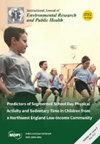翻译和改编的巴西版精神作用药物使用者家庭成员行为支持量表:因子结构和内部一致性分析
3区 综合性期刊
Q1 Medicine
International Journal of Environmental Research and Public Health
Pub Date : 2024-09-18
DOI:10.3390/ijerph21091230
引用次数: 0
摘要
目的:精神活性物质使用者家庭成员的助长行为对维持成瘾至关重要。目前还没有经过心理计量学评估的工具来测量精神药物使用者家庭成员的促成行为频率。因此,本研究旨在评估行为促成量表的内部一致性和因子结构。研究设计本研究是一项横断面研究,对从使用巴西热线服务的 400 名精神药物使用者家庭成员处收集的数据进行了二次分析。对最初的 200 份协议样本进行了探索性因子分析,并对剩余的 200 份协议进行了确认性因子分析。分析结果两个样本的内部一致性估计值完全令人满意,第一个样本的 Cronbach's alpha 为 0.76,第二个样本的一致性估计值为 0.79。使用 15 个项目的简化版工具进行了因子分析,提取了 6 个因子,占量表解释方差的 65%。KMO = 0.68 和巴特利特的球形度检验 = X2 (gl = 153) 497.201,p < 0.0001,均具有显著性。结论巴西版行为促成量表是一种有效的工具,可以测量精神活性物质使用者家庭成员促成行为的频率。该测量工具有助于进一步调查家庭成员对其亲属使用精神活性物质的行为。本文章由计算机程序翻译,如有差异,请以英文原文为准。
The Translated and Adapted Brazilian Version of the Behavioral Enabling Scale for Family Members of Psychoactive Substance Users: An Analysis of the Factorial Structure and Internal Consistency
Objective: The enabling behaviors of family members of psychoactive substance users can be crucial in maintaining addiction. There are no psychometrically evaluated instruments to measure the frequency of the enabling behaviors of family members of psychoactive substance users. Therefore, this study aimed to assess the internal consistency and factor structure of the Behavioral Enabling Scale. Design: A cross-sectional study was carried out, with a secondary analysis of data collected from 400 family members of psychoactive substance users that used a hotline service in Brazil. Exploratory factor analysis was conducted with an initial sample of 200 protocols, and with the remaining 200 protocols, a confirmatory factor analysis was conducted. Results: The internal consistency estimate proved entirely satisfactory in both samples, where the first presented a Cronbach’s alpha of 0.76 and the second had a consistency estimate of 0.79. Factor analysis was conducted using a shortened version of the instrument, with 15 items, during which six factors that cover 65% of the scale’s explained variance were extracted. KMO = 0.68 and Bartlett’s test of sphericity = X2 (gl = 153) 497.201, p < 0.0001, were significant. Conclusion: The Brazilian version of the Behavioral Enabling Scale is a valid tool that measures the frequency of the enabling behaviors of family members of psychoactive substance users. The measurement instrument enables further investigations into the behavior of family members regarding the use of psychoactive substances by their relatives.
求助全文
通过发布文献求助,成功后即可免费获取论文全文。
去求助
来源期刊

International Journal of Environmental Research and Public Health
Medicine-Public Health, Environmental and Occupational Health
CiteScore
7.30
自引率
0.00%
发文量
14422
审稿时长
1 months
期刊介绍:
International Journal of Environmental Research and Public Health (IJERPH) (ISSN 1660-4601) is a peer-reviewed scientific journal that publishes original articles, critical reviews, research notes, and short communications in the interdisciplinary area of environmental health sciences and public health. It links several scientific disciplines including biology, biochemistry, biotechnology, cellular and molecular biology, chemistry, computer science, ecology, engineering, epidemiology, genetics, immunology, microbiology, oncology, pathology, pharmacology, and toxicology, in an integrated fashion, to address critical issues related to environmental quality and public health. Therefore, IJERPH focuses on the publication of scientific and technical information on the impacts of natural phenomena and anthropogenic factors on the quality of our environment, the interrelationships between environmental health and the quality of life, as well as the socio-cultural, political, economic, and legal considerations related to environmental stewardship and public health.
The 2018 IJERPH Outstanding Reviewer Award has been launched! This award acknowledge those who have generously dedicated their time to review manuscripts submitted to IJERPH. See full details at http://www.mdpi.com/journal/ijerph/awards.
 求助内容:
求助内容: 应助结果提醒方式:
应助结果提醒方式:


